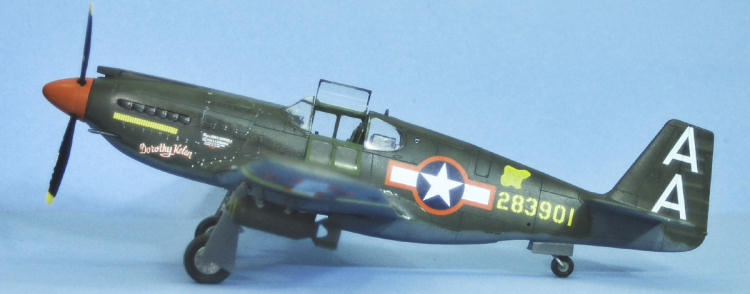
Hobbycraft 1/32 A-36A "Invader"
| KIT #: | 1710 |
| PRICE: | $54.00 MSRP |
| DECALS: | Five options |
| REVIEWER: | Tom Cleaver |
| NOTES: | Zotz 32-024 “North American A-36A Apaches in the MTO” used. |

| HISTORY |
During the production run of Mustang I airplanes, North American
delivered two to the USAAF for test and evaluation.
Since the Air Force hadn’t asked for them, and they were viewed as
“foreign,” the two airplanes sat at Wright Field, unwanted and neglected for
several months. Once flown,
however, they received glowing reports from the test pilots, with a
recommendation that the airplane be placed into production for
The lack of imagination continued.
Since the RAF was using their Mustangs for tactical reconnaissance, the
The RAF had decided to develop a Mustang with ground-attack capability,
which resulted in the cannon-armed
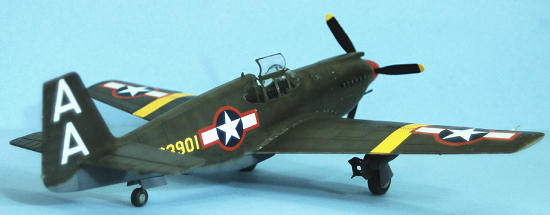 With no funds available for new fighter contracts in fiscal year 1942,
General Oliver P. Echols and Fighter Project Officer Major Benjamin S. Kelsey
wanted to ensure the P‑51 remained in production.
Appropriations were available for the development and acquisition of an
attack aircraft, since the Army had been impressed by the German Stukas.
General Echols specified modifications to the P‑51 to turn it into a dive
bomber, and a contract for 500 A‑36A aircraft fitted with bomb racks and dive
brakes was signed on April 16, 1942.
With no funds available for new fighter contracts in fiscal year 1942,
General Oliver P. Echols and Fighter Project Officer Major Benjamin S. Kelsey
wanted to ensure the P‑51 remained in production.
Appropriations were available for the development and acquisition of an
attack aircraft, since the Army had been impressed by the German Stukas.
General Echols specified modifications to the P‑51 to turn it into a dive
bomber, and a contract for 500 A‑36A aircraft fitted with bomb racks and dive
brakes was signed on April 16, 1942.
North American modified the P‑51 to use bomb shackles that had already
been tested in a "long‑range ferry" program for the RAF.
The design was completed in June 1942.
It utilized the basic P‑51 airframe and Allison engine, and "beefed up"
several high stress areas. A set of
hydraulically operated dive brakes were installed in each main wing. Due to the
slightly inboard placement of the bomb racks and the unique installation of the
four dive brakes, a complete redesign of the P‑51 wing was necessary.
The first A‑36A, 42‑83663, was rolled out in September 1942, with first
flight that October, and deliveries starting late that month. The A‑36A used the
nose‑mounted .50 caliber machine
guns of the Mustang I, with a wing armament of four .50 calibers.
The A-36A was powered by the sea level‑rated Allison V‑1710‑87,
delivering 1,325 hp at 3,000 ft, using
a 10 ft. 9 in. diameter three-bladed Curtiss‑Electric propeller. This
engine had greatly reduced output above 12,000 ft. The main air scoop inlet was
redesigned to become a fixed unit with a larger opening, which replaced the
earlier scoop which could be lowered into the airstream.
The A‑36 carburetor air intake was also later fitted with a tropical air
filter.
The official name "Apache" was assigned, though it was rarely used.
Many merely called it “Mustang”, and it received the unofficial name
“Invader” when a pilot of the 27th Fighter-Bomber Group told a
reporter that it was so called “because we keep invading places.”
The 27th
Fighter-Bomber Group:
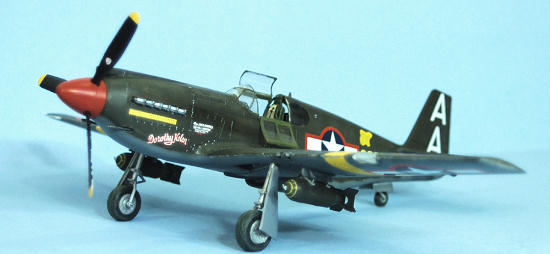 While the 86th Fighter Bomber Group(Dive) was the first unit
to be completely equipped and trained with the A-36A as initial equipment, the
airplane first saw operational service with the 27th Fighter Bomber Group, a
unit composed of four squadrons equipped with A-20 Havocs and P-39s, based at
Rasel Ma in French
While the 86th Fighter Bomber Group(Dive) was the first unit
to be completely equipped and trained with the A-36A as initial equipment, the
airplane first saw operational service with the 27th Fighter Bomber Group, a
unit composed of four squadrons equipped with A-20 Havocs and P-39s, based at
Rasel Ma in French
The two A-36A units moved onto Pantelleria in time for the invasion of
A myth has arisen that the dive brakes were useless due to malfunctions
and that they were soon wired closed.
My friend Capt. Charles E. Dills - who flew with the 522nd
Fighter-Bomber Squadron of the 27th Fighter‑Bomber Group - is adamant this is
not true. “I flew the A‑36A for 39 of my 94 missions, from November 1943 to
March 1944. The dive brakes were never wired shut in
Stateside training resulted in some alarming accident rates, with the
A‑36A at one point having the highest accident rate per hour's flying time of
any USAAF aircraft. The most serious incident involved an A‑36A shedding both
wings when its pilot tried to pull out from a 450 mph dive.
Combat units were ordered to restrict the approach to a 70-degree "glide"
attack and to stop using the dive brakes, but the order was generally ignored by
experienced pilots. Regardless of
the myths, the truth is that the A‑36A was very successful as a dive‑ bomber,
with a reputation for precision attacks right on the front lines.
Both the 27th and 86th Groups were involved in air
support during the Sicilian campaign, during which they became especially adept
at taking out enemy gun positions and other strong points as the Allies armies
advanced. It was during this campaign that the 27th Group circulated
a petition to adopt the name "Invader," receiving unofficial recognition of the
more fitting 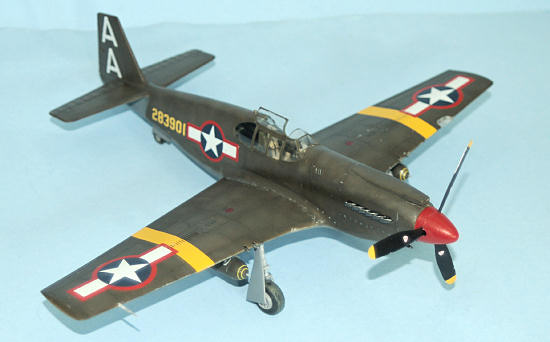 name from 12th Air Force HQ. To the German troops on the
receiving end of A-36A attacks, the airplanes were known as "screaming
helldivers."
name from 12th Air Force HQ. To the German troops on the
receiving end of A-36A attacks, the airplanes were known as "screaming
helldivers."
While it was a dive bomber, the A‑36A was credited with 84 enemy aircraft
shot down and being the mount of the only Allison-Mustang "ace", Lieutenant
Michael T. Russo from the 27th Fighter Bomber Group, who was also the
first “Mustang ace” in any kind of Mustang.
However, according to Charles Dills, Russo was not particularly
well-respected in the unit because
“... he was seen as being mostly out for himself; for us, dropping your
bombs before an attack meant the enemy won.”
As operations moved to the Italian mainland and fighting intensified, the
A‑36A suffered an alarming loss rate, with 177 falling to enemy action by the
end of February, 1944. The main
reason was that the A‑36A operated "on the deck" against murderous ground fire.
German defenses included placing cables across hill tops to snare the
attacking A‑36As. The Achilles'
heel of the A‑36A - and all
Mustangs - was its vulnerable cooling system, with even the slightest damage
there leading to many of the losses.
According to Charles Dills, by late February 1944, following the high
loss rate incurred over the Anzio beachhead, there were 120 A-36As left in the
theater, which was only enough to equip one group.
It was decided that the two group commanders would flip a coin to see who
got to keep all the A-36As. “We
lost.”
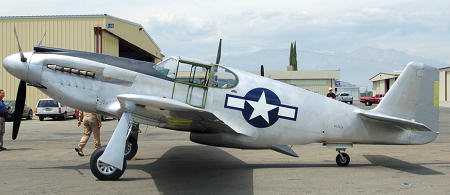 Beginning in March, 1943, war-weary P-40F and P-40L aircraft were
collected from around
Beginning in March, 1943, war-weary P-40F and P-40L aircraft were
collected from around
In June, 1944, the P-40s were replaced by P-47 Thunderbolts, which the 27th
Fighter Group used for the invasion of
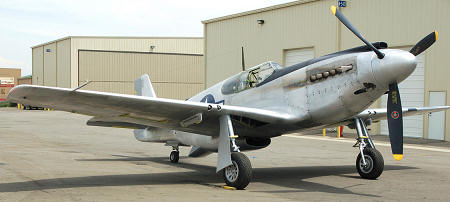 Of the 500 A-36As produced, four remain.
A‑36A 42‑83665 is on display
at the National Museum of the United States Air Force in Dayton,
Of the 500 A-36As produced, four remain.
A‑36A 42‑83665 is on display
at the National Museum of the United States Air Force in Dayton,
| THE KIT |
Hobbycraft of Canada licensed the Accurate Miniatures 1/48 Allison
Mustangs, for reproduction in 1/32 scale.
This has not actually resulted in a “bigger” Accurate Miniatures Mustang,
but has resulted in what is right now the most accurate series of Mustangs in
1/32 scale produced in injection-molded plastic.
Overall, the parts are somewhat “clunky” and heavy, and lack the sharp
trailing edges on wings and tails of the smaller kits.
There is also more flash than one might expect from a mainstream kit.
Essentially, if you think of these kits as being somewhere between a
mainstream injection molded kit and a limited-run kit, you’ll have it about
right. Sadly, as was the case with
the P-51A reviewed here by Bill Koppos earlier this year, the windscreen does
not fit, being slightly undersized.
I was able to fix this using an extra vacuformed canopy from Jerry Rutman’s
resin P-51B kit, but the only other way I can think of to fix this problem would
be to vacuform a replacement from the kit windscreen, which would then be the
right size to fit.
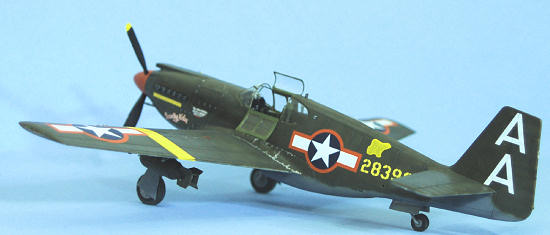 The plastic has that “pebbly” surface that has been noted with other
inexpensively-produced kits. This
will disappear under the proverbial “coat of paint.”
The fabric detail on the rudder and elevators is a bit heavy, but also
looks all right once painted. The
rest of the kit uses petite engraved panel lines that look right.
The plastic has that “pebbly” surface that has been noted with other
inexpensively-produced kits. This
will disappear under the proverbial “coat of paint.”
The fabric detail on the rudder and elevators is a bit heavy, but also
looks all right once painted. The
rest of the kit uses petite engraved panel lines that look right.
Very good decals are provided to do five different airplanes.
However, a better and more interesting choice is to use the new Zotz
Decals “North American A-36A Apaches in the MTO”, which provides markings for
two A-36As of the 27th FBG, including “Margie H”, the airplane
memorialized in the Air Force Museum, and “Dorthy Helen” of the 522nd
FBS. 27th FBG, and “Piggy
At first, I thought the spinner was too long and “pointy,” but comparing
it with the photos I took of the A-36A out at
| CONSTRUCTION |
Construction is straightforward, with fit being mostly “good enough”
overall, but needing test-fitting before committing to glue.
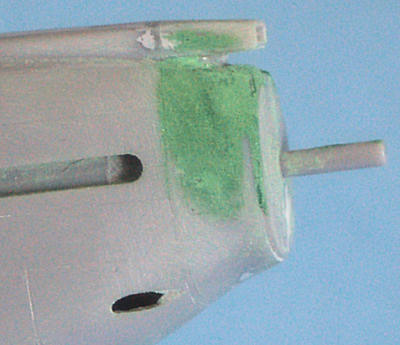 The cockpit is good and assembles without difficulty.
I made it better with a set of Eduard photo-etch seatbelts and some
photoetch panels over the “black boxes” on the right side of the cockpit, for
added detail.
The cockpit is good and assembles without difficulty.
I made it better with a set of Eduard photo-etch seatbelts and some
photoetch panels over the “black boxes” on the right side of the cockpit, for
added detail.
I glued the forward fuselage pieces to their respective rear section
before further assembly, so I could get the joint nice and tight by working on
it from both sides.
The nose part is mis-cast, with a concave section throughout, rather than
only on the lower third as it should be.
I corrected this with putty and a sanding stick.
I found I needed cyanoacrylate glue on the fuselage centerline seam to
finally make it disappear.
Since every picture Charles Dills has shown me of A-36As of the 27th
FBG have the inner wheel doors fully closed and the flaps up, I did not attempt
to replace the flaps, and glued the gear doors in the up position when I did the
wing sub-assembly. I also glued
Evergreen sheet inside the dive brakes, which are otherwise, “see through,” and
constructed a landing light box in the left wing to avoid the “open hole” look
there. You also must attach the
tail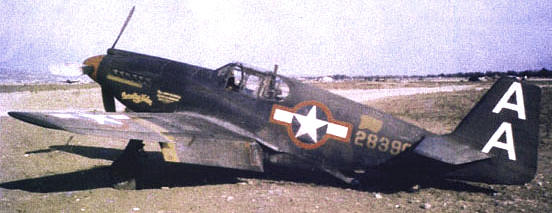 wheel before gluing the fuselage halves together.
wheel before gluing the fuselage halves together.
Working from a photograph of the real “Dorthy Helen,” I did not attach
the radio antenna mast, which had been removed on this airplane. (The photo is
provided here under “fair use” for your education)
The bombs in the kit are acceptable, but I used a set left over from a
Trumpeter model, since they included sway braces, which this kit did not have.
| COLORS & MARKINGS |
Painting:
With a nice color photo of the original subject at hand, I used
Gunze-Sangyo “Olive Drab” mixed with Tamiya “”Desert Yellow” to get the faded
look to the upper colors shown in the photo.
The lower surfaces were painted with Tamiya “Neutral Grey.”
I went out of my way to “fade” the upper surfaces, since Charles Dills
had told me the airplanes were badly faded under that hot Mediterranean sun.
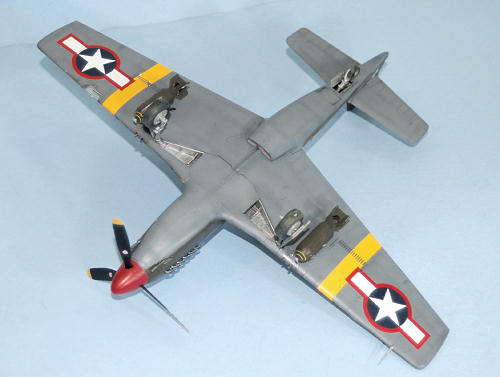 Decals:
Decals:
The Zotz decals went on without a problem.
I used the kit decals for the yellow wing I.D. stripes, and used stencil
decals from a SuperScale sheet.
| FINAL CONSTRUCTION |
This is a model of “Dorthy Helen” as she appeared at the outset of the Sicilian campaign. At that point, the airplanes had been in service a little more than two months, and were not as badly faded and worn as they were later during the Italian campaign. From the color photo, it is apparent there are only a few dings and some exhaust staining, which is how I did the model. After being washed, it was given two coats of Xtracrylix “Flat” Varnish.
| CONCLUSIONS |
For some reason, these Allison Mustang kits have gotten a “knock” from
modelers when they were first released.
In fact, they make up into a nice model and are far more accurate than
any other 1/32 P-51s available, other than Jerry Rutman’s all-resin 1/32 P-51B.
A nice model can be created right out of the box, though the Zotz decals
provide markings that have not been generally available for the A-36A before and
result in a more colorful model.
Review Kit courtesy of my
wallet.
Zotz decals courtesy of Zotz: get yours at www.zotzdecals.com
June 2010
If you would like your product reviewed fairly and quickly, please contact me or see other details in the Note to Contributors.